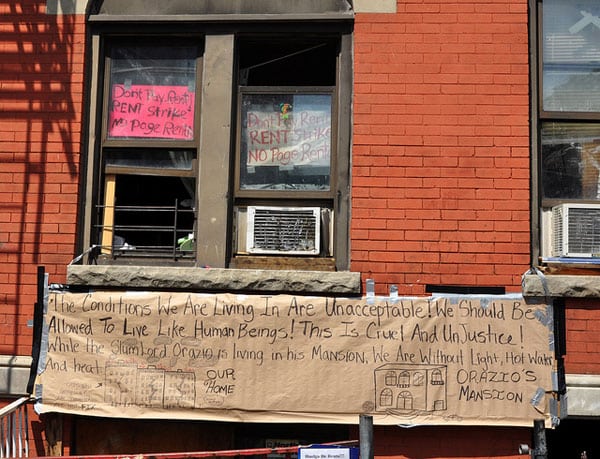
June 11, 2018; Next City
Rachel Kaufman’s article “Rent Strikes Heating up Nationwide, Say Tenant Organizers” starts with an appropriate note of nostalgia. The trend that Kaufman identifies is based on stories in the Washington Post and the Toronto Star, but any quick perusal of the internet could find dozens of other examples of tenants taking direct action against gentrification by withholding their rents.
The very term “rent strike” rings a 1960s chime, but rent strikes actually go back to at least the turn of the last century when Progressive Era unrest in East Coast cities precipitated rent-withholding campaigns, most notably in New York City. In the absence of any local government regulations of rents or housing conditions, renters emulated their labor union cousins and challenged landlords to accept financial losses from unpaid rents and the cost of eviction or capitulate to tenant demands. Back then, the issue wasn’t gentrification of tenement slums; it was simple affordability.
Three features make rent strikes an attractive tactic to renters and organizers.
- Low cost. Simply not paying the rent doesn’t require a lawyer or organizer.
- Fairness and equity. Tenants perceive a natural balance in the exchange of rent for services. That common sense equity is an easy proposition to “sell” to the general public
- High engagement and solidarity. Mass participation provides some “safety in numbers” and some opportunities for everyone to make a contribution. The social roots of rent strikes are critical to success.
Advocates are often warier of rent strikes as a be-all, end-all tactic. For many activists, rent strikes are the “casework” of social change. The Star quotes City Councilor Gord Perks as saying that “rent strikes are a temporary solution.” According to Councilor Perks, “It’s good that this particular group of tenants and the previous group of tenants who participated in a rent strike have been able to win some concessions…[B]ut I believe we need a larger structural solution because I can tell you for every one person who’s succeeded in avoiding an above-guideline rent increase, I’m hearing from 10 who haven’t.”
Sign up for our free newsletters
Subscribe to NPQ's newsletters to have our top stories delivered directly to your inbox.
By signing up, you agree to our privacy policy and terms of use, and to receive messages from NPQ and our partners.
Advocates and organizers agree that keeping a grassroots movement together is a lot of work. There are too many ways for free riders to join the effort and for “turncoats” to undermine the resolve of the rent strikers. In many case, laws enacted to protect tenants’ rights have made old fashioned rent withholding much more complex. Organizers, lawyers and bookkeepers may be required to keep the effort on track…more like a corporation than a mass action.
Last year, NPQ profiled the emergence of the “Renter Nation” movement in connection with eviction reform. “Renter Nation” arises from the post-Recession reality of a growing number of households across the country choosing rental housing instead of homeownership. Two types of renter networks capture this movement. The Homes for All (HFA) campaign provides online training, mutual support, and technical assistance to local organizations around the country. The Nation recently invited readers to “Meet the Rising New Housing Movement That Wants to Create Homes for All.” On a smaller geographic scale, Los Angeles’ Coalition for Economic Survival (CES) provides professional organizing services to local rent-strikers and acts as a lobby voice at local and state government levels. For both CES and HFA, rent strikes are the entry level for tenant activists to grow into broader civic involvement. At the same time, both networks are supported by grassroots involvement rather than top-down professional advocates.
Networks that encompass a range of policy interests or span a range of localities around the country can overcome the limitations of the traditional site- and issue-specific rent strike.
Recent legislative setbacks like the defeat of just cause protections for California renter households or the reversal of the Seattle head tax show that the Finance, Investor, Real Estate, Developer (FIRED) lobby is pushing back against elected officials who are pledged to support their voting constituents. In both cases, money appears to have tipped the balance against voter interests. Still, the fact that the FIRED lobby has to play defense in multiple cities suggests that the Renter Nation is coming of age. While tenant politics must evolve new strategies (e.g., citizen initiatives and electoral politics), grassroots tenants engagement in the form of a rent strike can provide the fuel needed to build a national movement.—Spencer Wells












